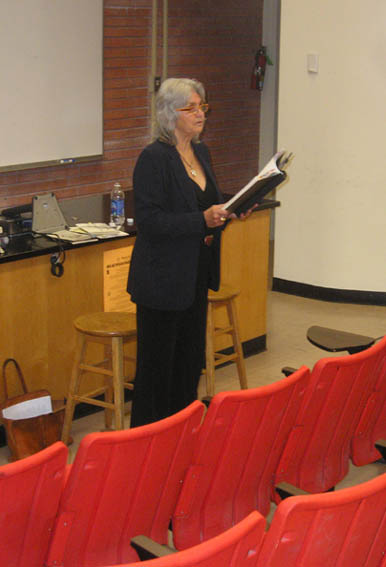
Julia Connor arrived at Sacramento City College in Lillard Hall and planted herself among the red chairs there like a gentian among the geraniums.
Connor, who is currently Sacramento's Poet Laureate but who has also taught at Naropa and studied with Robert Duncan, kicked things off by reading from “Making the Good,”her first attempt to put together a collection. Connor shared that, looking back, maybe she wasn’t ready to put a collection together at that point but that she was nevertheless delighted to be asked to do so. The poem she read was called “Epiphany” and it invoked the image of a risen scorpion, which according to the tenets of alchemy is the eagle.
From the same collection, she read “The Place of Dark Blue Flowers.”
She then read a section from a book called “Canto for the Birds,” whose origin was a zigzagging trip through the Sacramento Valley to Arizona with her husband. They were accompanied on that trip by a book Connor had received from State Parks and Recreation that showed all the preserves in the Central Valley. Also along on the trip was a book written by 14th Century alchemist Giordano Bruno, which Connor read aloud while her husband drove.
After this poem was read, Connor entertained a question from an audience member who asked her why she was so interested in alchemy in her poems. To which, Connor replied, “It’s like chemistry with a sense of humor.”She said she was also drawn to alchemy because, unlike chemistry, things still had powers. She also mentioned how alchemy also had correspondences between things, connections that allow one to connect in a substantive way with a larger world of objects. She mentioned that this kind of connection enlivens people in a way that chemistry cannot approach.
The next poem that Connor read was called “Hearth,”and it was derived from an incident relating to her two older sisters, one who is 12 years older, the other who is 14 years older. This was followed by “At Tommy Dollard’s House,” a poem about coming to terms with the impulse of male violence.
Connor then switched to reading from a series of prose poems. The first one was called, “Relations,” and it focused on her lifelong fascination with the shape of a mouth and how that shape informed the kind of person one might be, the kind of mental landscape one inhabited. This was followed by “The Theory of Snow”is a meditation on a winter scene that allows the speaker to acknowledge her own loneliness and her bitterness, which she then roots in “the clearing of a man.”
Nest up was “The Visiting Room,” a powerful story about an inmate struggling with his life-long grief for an early mistake he had made.
Finally, Connor ended with one of her signature pieces, “One February Eve on the Six O’ Clock News.”
No comments:
Post a Comment